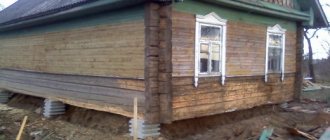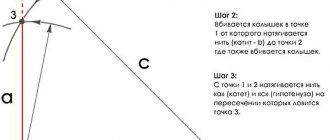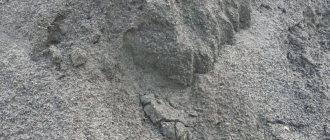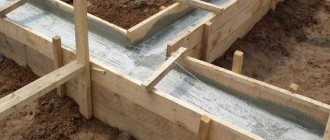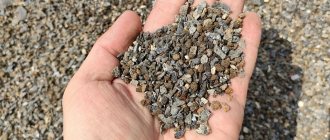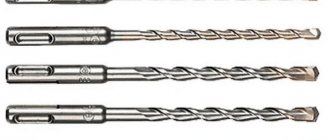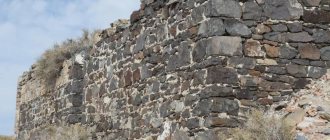Brick remains a popular building material, despite the presence of many alternative technologies used in private housing construction. Brick houses are famous not only for their spectacular appearance, but also for their quality; their successful long-term operation is largely determined by the properties of the foundation. Modern construction techniques make it possible to lay a high-quality foundation for a brick house, capable of adequately bearing the weight of a one- or two-story structure.
A capital structure needs a capital foundation Source remontik.org
Factors influencing the choice of foundation
The foundation of any building is designed to take on the weight of the structure, support it without deformation and transfer it to the underlying soil. A brick house is one of the most problematic buildings; not all types of foundations are suitable for it. The reason lies in the impressive mass of brick walls.
With an external wall thickness of 640 mm (thermal technical standard) and a height of 3 m, the mass of a linear meter of one floor will be 3460 kg. For comparison, a linear meter of a wall made of foam concrete (500 mm) will weigh 1350 kg, and one made of wood (300 mm) - 470 kg. It is clear that brick walls exert a serious load, and therefore strict requirements are imposed on the choice of foundation.
When designing, the foundation for a brick house is calculated based on several initial data. The calculations are influenced by both the characteristics of the house itself and some external reasons. The following factors are taken into account:
- The load of the house on the foundation (depends on the area, number of storeys, wall thickness).
The walls exert the main load on the base Source bg.decorexpro.com
- Physico-mechanical features of the soil at the building site. The soil can have different densities (which determines the calculation of the permissible load), be natural or bulk. The foundation on heaving soil is designed especially carefully.
- Soil water saturation . It depends on the groundwater level and affects the depth of soil freezing.
Drainage system for a brick house
When the groundwater level is high, to protect strip and slab foundations from erosion, it is necessary to provide a wall drainage system. It is necessary to equip it at the stage of laying the foundation, so as not to carry out excavation work to excavate it again in the future.
Rice. 2.1 : Scheme of wall drainage system
Drainage pipes are located around the perimeter of the house, encircling the contours of the foundation. They are placed 10-20 centimeters below the supporting heel of the base. In the corners of the house, pipes are brought into inspection wells, which are connected to the main storage tank located at the lowest point of the site so that water from the inspection wells flows into the container by gravity. Water is pumped from the main reservoir outside the site.
Shrinkage of brick buildings
Most people are of the mistaken opinion that only wooden structures are at risk of deformation, while brick buildings are free from such problems. In fact, the concept of shrinkage of a brick house is known to all professional builders; This refers to the shrinkage of the foundation. Since the weight of load-bearing walls reaches significant values, shrinkage can also become significant and lead to the appearance of cracks in the walls. The intensity of shrinkage is determined by the properties of the soil - the softer it is, the more the foundation of the house will sink. To reduce negative processes, a cushion is laid under the foundation of the building - a layer of concrete, sand or crushed stone.
Consequences of uneven shrinkage Source stroi-x.com
The period of shrinkage of a brick country house can last for several years (sometimes 5-6 years). To ensure that the process proceeds evenly and does not damage the integrity of the building, the importance of selecting the right foundation becomes obvious. Special technological techniques during the construction of walls also help to avoid cracks. Special expansion joints are left in the brickwork. They last for one to two years and serve as a good preventive measure against the occurrence of not only shrinkage cracks, but also temperature cracks.
After the project has been prepared and a clear understanding of the objective conditions of the construction site has been obtained, the type of foundation is determined. Three types of foundations can support a two-story brick house: strip, pile and slab.
Selecting the type of base
First of all, you need to determine the total weight of the structure, i.e.
K. brick is a heavy building material. If the foundation turns out to be weak, after some time the house will begin to shrink, cracks will appear on the walls, which will ultimately lead to partial, and in some cases, complete destruction of the house.
The following types of foundations are most suitable for brick houses:
- recessed strip; reinforced concrete pile; slab.
Other types of foundations, including shallow strip and columnar metal foundations, are not suitable for brick buildings, because
because they will not be able to withstand the load. To choose the foundation that is optimally suited for a particular option, you need to consider:
- shape of the relief; depth of soil freezing; physical and mechanical characteristics of the soil; depth of groundwater.
Only specialists can make a realistic assessment of these indicators, so the cost of their services must be included in the list of expenses for building a house.
Strip foundation of a brick house
Visually, the strip-type foundation fully corresponds to the name. It has the form of a contour reinforced concrete strip running along the perimeter of the house (under the load-bearing walls) and under the internal partitions. The tape type has become widespread due to the following advantages:
- Ease of execution.
Construction of a strip foundation Source stroy-dom-pravilno.ru
See also: Catalog of companies that specialize in foundation repair and design.
- Durability . Service life exceeds 50 years.
- Ability to withstand significant loads without deformation .
- Applicable for any projects . Base strips can be used as wall structures for a basement or ground floor.
The disadvantages of the tape type are its following features:
- Cost . Significant material, time and human resources are required.
- Restrictions . Strip foundations are not used on some soil types. It also imposes restrictions on the choice of architectural form of the building. The depth of the strip foundation for a two-story house is determined for each project individually, based on its features and the characteristics of the site.
The basis of quality is a properly poured concrete mixture Source nearsay.com
There are several types of strip foundations:
- Monolithic . Solid concrete structure, the most durable and therefore the most common option for brick buildings; the weight of the structure on such a foundation is distributed evenly. A trench is dug along a given perimeter, a cushion of crushed stone and sand is laid on the bottom, a layer of waterproofing is installed, and wooden formwork (bounding surfaces) is installed. A reinforcing belt is installed (steel reinforcement secured in a special way). The concrete solution is poured into the formwork and further compacted. The disadvantage of this method is that you have to wait until the concrete mixture hardens and gets stronger.
- Prefabricated (block) . Finished reinforced concrete blocks are laid in the order specified by the project in a trench and fixed. The disadvantage of this method is the need to use special equipment to move individual elements. A prefabricated base is less durable than a monolithic one
- Shallow-recessed . It is not suitable for two-story buildings made of stone or brick, since it goes into the ground a little more than half a meter.
Scheme of a prefabricated strip foundation Source remoo.ru
A monolithic foundation can be constructed in two ways:
- If the house design includes a basement or basement , then at the first stage a pit is dug, at the bottom of which a reinforced concrete layer is constructed. After it hardens, the basement walls are erected. Such a foundation turns out to be the most reliable; it is designed for two- and three-story brick buildings.
- If the design of a two-story brick house does not include a basement , a standard strip base is installed. Its depth is determined by increasing the depth of soil freezing by 30-40 cm.
How to build a strip base
First you need to prepare the site for the foundation. When all the garbage has been removed, it is necessary to remove the layer of soil and mark the boundaries of the future building. It is very important to calculate the correct angles when marking. The next step should be to dig a pit or trench, depending on the project.
Which is better - with your own hands or with an excavator? It does not matter. When preparing a pit or trench, it is recommended to provide a margin of about two meters, for the convenience of subsequent work with formwork.
Using a theodolite, depth consistency is measured at all locations in the trench.
In the case of constructing a monolithic belt type, it is necessary to water the entire trench and place a gravel-sand cushion on top, the depth of which is 20 cm. The cushion must subsequently be compacted using a vibrating plate.
For the prefabricated type, the procedure is identical, except that compaction is carried out at the locations of the blocks.
Why is special equipment needed to install a prefabricated base? It's simple - reinforced concrete blocks have a lot of weight. They are held together using sand-cement mortar and the process is similar to bricklaying. The monolithic type of strip foundation involves the installation of formwork. The formwork can be made from wooden boards or from collapsible frame-panel structures.
This is what a finished monolithic foundation looks like
It is recommended to ensure that the vertical walls are maintained during the installation process. On average, the height of the foundation above ground level is forty centimeters, for areas with wet soil a little more.
The next step on the path to a finished foundation is the installation of a frame made of reinforcement. It is cut to the required length and knitted together. The structure is then lowered onto brick supports into the trench. After constructing the frame, it is necessary to prepare a solution and pour it into the formwork.
The process is carried out in layers (depth 20 centimeters). Each layer must be freed from the resulting voids using a shovel, with your own hands, or better yet, using a vibropress. To create strong foundation properties, it is recommended to prepare a solution of medium fat content. As a rule, the foundation dries completely within one month.
Diagram of a monolithic foundation
It is best to moisten the solution with water at the very beginning, this is necessary to prevent it from drying out. When the foundation is completely dry, it is necessary to remove the formwork and lay the roofing material. The final stage is filling the base with soil.
Pile foundation
A pile foundation for a brick house, a two-story or one-story project, is designed for an area with fragile, crumbling soil, and is characterized by the following parameters:
- The use of piles helps transfer the main load from a building to deeper, stronger layers of soil , bypassing the unreliable top layer.
- The upper part of the piles , remaining on the surface, is tied into a single structural element using a reinforced concrete grillage . The building rests on this contour, but most of the load is carried safely on the piles.
Fragment of a pile foundation Source domvita.ru
- The pile method involves the use of special equipment for drilling wells and installing piles. This leads to additional costs, but is compensated by the speed of installation and ease of installation.
- The use of piles is economically justified in areas with dense soil . The method allows you to equip a foundation designed for fairly high loads, and the calculations must be carried out very accurately.
- The use of piles is not economically justified when building on water-saturated soil . In order for the foundation to fully support a two-story brick building, it will need to be strengthened. As a rule, this will require an increase in the number of piles. It will be necessary to use piles of larger cross-section and immerse them to greater depths. In addition, a powerful grillage contour for cutting the piles will be required. Such changes can negate the efficiency of the pile method.
Construction of houses
0 votes
+
Vote for!
—
Vote against!
The basis of any house is its foundation. When creating this structural element, work must be done with special care. After all, the strength of the brick house built on it directly depends on the correctly chosen type of foundation and on how well it is created. Of course, you can create a reliable foundation for a brick house with your own hands, and this will require very little. It is enough to understand the different types of foundations, know about their strengths and weaknesses, and also be able to handle the tool.
- Choosing a foundation type
- Strip foundation for a brick house
- Pile foundation for a brick house
- Slab foundation for a brick house
- Strengthening the foundation of a brick house
- Injection enhancement
- Pile strengthening method
- Arrangement of reinforced concrete frame
- Arrangement of protective walls
- Sole widening
- Strengthening the foundation: video demonstration
Choosing a foundation type
When planning to create a brick foundation for a house, you should take into account its large mass. Otherwise, the construction of a foundation that is not designed for heavy loads will lead to the appearance of cracks on the walls of the house and its partial destruction. This is why technical inspections of buildings are done. Several types of foundations can withstand the load created by a brick house, namely: strip, pile, slab.
Important! It is not customary to use shallow and columnar foundations for a brick house. But this is only true for a shallow strip foundation and a columnar foundation made of metal pipes, since they cannot withstand the heavy load of a brick house.
Regardless of which foundation you personally prefer, there are a number of specific requirements and standards for each of them. And the correct foundation for a brick house can only be created if these standards are observed. When choosing one type of foundation or another, you must consider the following:
- physical and mechanical characteristics of soil;
- relief;
- depth of soil freezing;
- ground water level.
Video: Types of foundations
To obtain detailed information, it is best to invite a specialist who, after a thorough check, will provide detailed data on the characteristics of the soil. Only after this can you begin to select and arrange the foundation. If you already know about the properties of the soil on your site, then the tables below indicate the dependence of various types of foundation on the characteristics of the soil.
Table 1 - Dependence of the choice of foundation type on soil type
Table 2 - Dependence of the choice of foundation type on the future structure
Table 3 - Foundation depth for a brick house depending on the type of soil and groundwater level
Strip foundation for a brick house
The popularity of strip foundations is enormous. A strip foundation is erected under a brick house, under a house made of concrete or stone, in cases where massive concrete floors are used in the structure. It can withstand heavy loads and stands out for its simplicity. The foundation strip is placed around the perimeter of the building and under the internal walls. Another undeniable advantage of a strip foundation is the possibility of creating a basement or basement where the foundation strip will serve as the walls.
Strip foundations are divided according to the type of construction into prefabricated and monolithic. Monolithic ones are a solid, reinforced concrete structure. Such a foundation has high strength characteristics, and the work on its construction can be done independently. Unfortunately, the main disadvantage of a monolithic foundation is the long time it takes to solidify and gain strength. A prefabricated foundation consists of stone or concrete blocks. It is being built somewhat faster, but additional labor and special equipment will be required to complete all the work. Unlike a monolithic foundation, a prefabricated foundation has lower strength characteristics.
Also, the division is based on the load on the ground - shallow and buried. Foundations with a depth of 50–70 cm are considered shallow A shallow foundation for a brick house will not be able to support its weight, so for houses made of brick, concrete and stone, a buried foundation . Such a foundation is laid 30 cm below the soil freezing level and in cases where the project includes a ground floor or basement. For a strip foundation for a brick house, the price starts from 180 USD. per m3. In addition, the cost of a foundation for a brick house is also affected by the distance from a large city, where all the necessary materials are available.
To create a strip foundation, you need to do the following:
- we clear the area, remove the layer of turf and mark the place for the future foundation. We make sure that the corners are strictly straight;
- Using an excavator or manually, we dig a trench or foundation pit of the required depth for the foundation. What exactly you have to dig depends on the design of the house. If it has a ground floor or basement, then we dig a pit, and if without, then a trench. We make the dimensions of the pit or trench 1.5 - 2 larger. This is necessary for the convenience of arranging formwork and pouring concrete. We carefully level the bottom horizontally and use a theodolite to check the depth mark in the corners;
- for a monolithic strip foundation, the bottom of the trench is watered and sprinkled with a layer of a mixture of fine gravel and sand 200 mm thick. After which the entire surface is carefully compacted with a vibrating plate. Finally, the cushion is covered with waterproofing and poured on top with a small layer of lean concrete. For a prefabricated foundation, the same operations are performed with the only difference being that compaction and creation of a cushion is carried out only in the place where concrete blocks will be installed;
- To create a prefabricated foundation, you will need to use special equipment, since concrete blocks have a large mass. We install the blocks in their place and fasten them with cement-sand mortar. The method of laying blocks is the same as when laying bricks. The only difference is in size;
- To create a monolithic foundation, we first install formwork from wooden boards 40–50 mm thick, which are rigidly fixed with spacers. But it is most convenient to use frame-panel collapsible formwork. During installation of the formwork, it is necessary to check the verticality of the walls. The height of the foundation above ground level should be at least 40 cm, and more for wet soils. According to this, the height of the formwork is also made;
Important! To ensure good insulation of the base of the foundation, roofing material is laid at the bottom, the edges of which are brought up.
- Next, we create a reinforcement cage for the strip foundation. For it we use reinforcement bars with a thickness of 6 mm to 10 mm. Having cut the required number of rods of the required size, we weld them together. We lower the finished frame into the trench on pre-arranged supports made of brick or stone;
- Now all that remains is to prepare the concrete and pour it inside the formwork. The pouring process itself is performed in layers of 15–20 cm, in several approaches. After each approach, the concrete is shaken with a vibrating hammer or other available tool, such as a shovel. This is done to eliminate voids and create a solid foundation;
Important! In order for the foundation to be strong, the consistency of the concrete should be of medium fat content. Such concrete does not flow around obstacles, and some effort must be made to move it.
- Leave the freshly poured foundation until completely dry. This may take about a month. At the same time, at first it is necessary to water the surface so that the concrete does not dry out and crack;
- After the concrete has hardened, the formwork is removed and the foundation is waterproofed. For these purposes, you can use various rolled, coating and other waterproofing materials;
- Finally, we fill the foundation. We do this with extreme caution so as not to damage the waterproofing layer.
Pile foundation for a brick house
This type of foundation is installed in cases where construction is carried out on crumbling soils that are not able to withstand the heavy load of a brick house. When using a pile foundation, the load is transferred to denser layers of soil located at great depths. Its design consists of individual piles connected at the top by a concrete or reinforced concrete grillage, on which the walls of the house rest. A pile foundation for a brick house can also be built on more durable soils, thereby reducing the amount of materials used and the amount of excavation work. Among the disadvantages of this type of foundation, it is necessary to note the use of special tools and equipment for drilling wells or driving them into the ground.
There are many types of pile foundations made of different materials. Of these, a bored reinforced concrete foundation with wide pile bases . You can build such a foundation either independently or using special equipment. The price of a pile foundation is somewhat lower, but still very much depends on the distance from the city. The further you go, the more expensive it is. To create a pile foundation, you must do the following:
- we clear the area, remove the layer of turf and mark the place for the future foundation. We make sure that the corners are strictly straight;
- we mark places for the piles. To do this, starting from the corners, with the step indicated in the project, we make a small excavation under each of the piles for further drilling;
- Now, using a special drill or ordered special equipment, we drill wells for piles;
- While drilling is being done, you can prepare the reinforcement bars and weld them together for the reinforcing frame. The length of the frame should be 20 - 30 cm above ground level. This is necessary for further tying the frame for the grillage to it;
Important! If there is a need to raise the piles above ground level, metal pipes of the required diameter can be used as formwork for them.
- Upon completion of drilling, pour a small layer of gravel mixed with sand onto the bottom. Next, we lower the reinforcing frame and fill it with concrete. Don’t forget to shake the concrete to remove voids and create a monolithic structure. The concrete itself can be prepared directly on site;
- While the concrete in the piles is hardening, we make a reinforcing frame for the grillage and tie it to the frame of the piles. Then we make formwork, which we place around the grillage’s reinforcing frame;
Important! As a formwork for the grillage, the most suitable option would be prefabricated panel formwork. It is easier to install and strengthen, and the finished grillage will be of higher quality.
- After installing the formwork, pour concrete inside. Just as in the case of a strip foundation, we carry out all the work in several approaches, shaking and compacting the concrete;
- All that remains is to let the concrete dry and gain strength, after which the grillage can be waterproofed and the construction of walls can begin.
Slab foundation for a brick house
The simplest in design and arrangement is a slab foundation. In fact, it is one solid reinforced concrete slab on which the entire house rests. Another important difference from pile and strip foundations is its ability to withstand loads during uneven horizontal and vertical ground movement without damage to the entire house. This type of foundation is installed mainly on heaving and subsidence soils, as well as on soils with a high moisture content.
Slab foundations are usually divided into shallow , shallow and deep . The non-buried version of the slab foundation is installed directly on the ground. The depth for a shallow slab foundation is within 50 cm. Such foundations are also called floating foundations. A deep slab foundation is placed just below the freezing point of the soil.
You can create a slab foundation from a lattice or solid slab, which is cast from high-quality concrete, from prefabricated reinforced concrete beams laid crosswise with a rigid connection, as well as from prefabricated reinforced concrete slabs with the obligatory creation of a monolithic covering.
Of the slab foundations, the most affordable and easiest to create with your own hands is a shallow monolithic slab foundation. Such a foundation will allow you to significantly save on concrete and labor costs. The cost of a foundation for a brick house depends on the area of the house and the distance from the city. The price starts from 90 USD. To create a monolithic slab foundation, you must do the following:
- we clear the area, remove the layer of turf and mark the place for the future foundation. We make sure that the corners are strictly straight;
- we make a small excavation to a depth slightly greater than the thickness of the future foundation;
- We level the surface and fill the entire area with a layer of crushed stone and sand. We carefully level the crushed stone and compact it. Pour a small layer of lean concrete on top;
- Unlike pile and strip foundations, slab foundations require higher quality hydro- and thermal insulation. Therefore, vinyl film, roofing felt, geotextiles are laid on top of lean concrete, and thermal insulation made of polystyrene foam, polystyrene foam, and polyurethane foam is laid on top;
- We make formwork around the perimeter of the foundation. Here you can safely use boards with a thickness of 40 - 50 mm. The main thing is to make powerful and reliable spacers for them;
- Now we are making a reinforcement cage. We cut the reinforcement and weld it together like a mesh. We carry out all work directly on the site of the future foundation;
- The final stage will be pouring concrete. It is best to do this in one go, so it would be rational to order a ready-made mixer with concrete, instead of making small portions in a regular concrete mixer. After pouring concrete, it must be thoroughly shaken and left to harden. During the first few days, the surface will have to be moistened with water.
Strengthening the foundation of a brick house
Sometimes after purchasing a house that has already been built, after some time you may notice cracks on the walls. This indicates a poor quality or weak foundation that is unable to support the weight of the house. There is a way out of this difficult situation - strengthening the foundation of the house. Of all the ways to strengthen the foundation of a brick house, the simplest and most affordable is to increase the area of the foundation. But there are other methods of strengthening.
Injection enhancement
To do this, you need to select the soil around the foundation and, using a special cement gun under high pressure, spray the solution onto the foundation wall.
Pile strengthening method
Wells are drilled next to the foundation walls, into which the reinforcing frame is lowered and filled with concrete.
Arrangement of reinforced concrete frame
Formwork is made around the foundation over its entire area, into which a reinforcing frame is placed and filled with concrete.
Arrangement of protective walls
A part of the soil is selected from the outside of the foundation, the formwork is arranged flush with the foundation cut and then filled with concrete.
Sole widening
Widening is carried out in the same way as in the case of protective walls, with the only difference being that the width of the foundation can increase by 50 - 100 cm.
Strengthening the foundation: video demonstration
Slab (monolithic) foundation
A good way to arrange the foundation of a two-story brick house. Such a foundation looks like a solid reinforced concrete slab on which the frame of the house is built. It is characterized by the following parameters:
- Laying depth . There are deep foundations (from a meter or deeper), shallow foundations (0.5-1 m) and non-buried foundations (up to 0.5 m).
- Duration of operation . It is the highest when compared with other types; the base is designed for 60-70 years of flawless service.
- Use on problematic soils . An ideal solution for heaving, weak and waterlogged soil.
- Minuses . The slab type is characterized by high construction costs and high time costs.
Necessity of application
The main reason for choosing a pile foundation is weak soil. These include: loess-like soil, which loses its stability at high humidity, plant soil with a large amount of peat, quicksand and loam, highly saturated with water.
In these cases, it is necessary to transfer the entire load from the brick house to denser soil located at depth.
The organization of a pile foundation is also often chosen to reduce the volume of earthworks and the costs of removing earth after digging a trench, backfilling and subsequent pouring of concrete.
Choosing a foundation and ways to strengthen it
The foundation of a two-story brick house is subject to special requirements in terms of strength and depth parameters. In most cases, the choice is made as follows:
- If the soil is not problematic , a strip foundation . It is made deeply recessed, and a wider grillage, according to calculations, is also laid.
- If the soil at a construction site is heaving (changes its volume during the annual freezing-thawing process), preference is given to a pile foundation , which can provide a significant margin of safety. Reinforced concrete pillars with a large cross-section are chosen for it, and only reinforced concrete grillage is laid. If a strip block (prefabricated) foundation is chosen, it is installed below the freezing layer, or the heaving soil is replaced with a backfill of sand or crushed stone.
- If the soil is wet , heaving or crumbling , a deep slab foundation .
How to prepare a pile-grillage foundation
Similarly, as in the case of preparing a strip foundation, it is necessary to clear the site, remove the layer of earth and make markings. Then it is necessary to mark points for the piles by removing soil in places that need to be calculated in the design documentation. Ultimately, holes for the piles are drilled at these points.
After this, at the bottom of the drilled holes there is a sand and gravel cushion, as well as a reinforcing frame (it is recommended to design the frame so that there are outlets of about 300 mm). Then, a concrete solution is poured into all the holes, which must be thoroughly shaken.
The next step is to prepare the frame that will be. It must be fixed to the pile frame, which is why the reinforcement releases were actually made.
Grillage foundation reinforcement scheme
After this, it is necessary to prepare the formwork and protect the grillage layer with it.
Further actions are similar to pouring a strip foundation. Also, after about a month of drying, you can build brick walls.
Video description
What types of foundation are there? How is the foundation built and how much does it cost? See all this and much more in this issue:
Scheme of a deep foundation Source kamtehnopark.ru
Sometimes there is a need to strengthen the foundation of a brick house. This can be done in a variety of ways, including:
- Strengthening by injections . The soil around the base is removed, and a cement solution is applied to the exposed base (special equipment is used).
- Reinforcement with piles . Piles are installed along the foundation.
- Reinforcement with reinforced concrete cage . Formwork is installed around the perimeter, a reinforcing belt is installed and concrete mixture is poured.
- Reinforcement with a protective wall . The outer wall is made of concrete, sometimes it rises to a height of up to one meter.
Reinforcement with reinforced concrete slab Source pallazzo.su
Features of the bookmark.
When planning the construction of a brick house, it is necessary to study in detail and strictly observe the following rules:
- The soil on which construction is carried out can be very diverse, and each has its own type of foundation.
- The lower edge of the foundation should always be 20-25 cm below the soil freezing level.
- Groundwater has a negative impact on the condition of the foundation, so during construction measures should be planned to combat it.
- During construction, use only high-quality materials.
- Carefully follow all construction technologies and safety measures.
A correctly selected, designed and manufactured foundation will allow a house built on it to stand for decades and serve many generations of its residents.
Principles of foundation calculations
The foundation for any buildings, including brick ones, is described by several parameters:
- Deepening . It is selected based on an analysis of the soil (density and bearing capacity) and freezing depth. There are tables relating soil type and recommended depth.
- Foundation load . It is calculated based on the total weight of the brick house. To do this, structural (walls, partitions, roofing, floors), internal (people and furniture) and external (snow on the roof) loads are summed up.
- Required (minimum) support area and base width . The total area of the concrete strip is determined by the bearing capacity of the soil and the load on the soil of the building along with the foundation. Knowing the area and perimeter, you can, by dividing the first by the second, calculate the width of the strip base.
A high-quality foundation will give a house a long life Source sever-dom.su
Ribbon type of structure.
Strip foundation diagram.
A strip foundation is a wall made of durable material sunk into the ground to transfer the weight of the main building to the ground.
The strip foundation, in accordance with its name, resembles a strip in appearance, is a wall made of durable material sunk into the ground to transfer the weight of the main building to the ground. The shape of the strip foundation must correspond to the design of the house and pass under all its load-bearing walls. It must withstand the wall of a two-story, and even more so a one-story house without deformation.
In turn, the strip foundation according to the method of execution is divided into 2 types:
The best choice for a two-story house
Choosing the most optimal foundation installation technology is the key to trouble-free, long-lasting construction
At this stage, it is extremely important to conduct a comprehensive analysis of the features of a particular object
In this case, it is necessary to take into account the maximum permissible loads on the supporting structure
To resolve the dilemma of which foundation is better, you should turn to statistical data. The widespread practice of using various types of foundations for a two-story brick house allows us to confidently state that strip technology in this case acts as the highest priority direction.
Manor
For example, the foundation for a two-story house made of foam blocks based on this technology has already gained popularity among many happy owners. The prerequisites for choosing the presented method are based on the optimal combination of various technical, material and operational criteria.
The advantages of this method are as follows:
- high level of load-bearing capacity;
- high performance indicators;
- resistance to deformation and tearing;
- ease of installation;
- low level of material costs;
- ease of maintenance;
- the ability to choose different types of layouts;
- minimum technical equipment.
Installation of formwork
It should be noted that all the positive aspects of the recommended technique will manifest themselves only subject to strict compliance with the requirements and the presence of good-quality materials.
Installation of a slab-type base.
The slab type foundation looks very impressive. It looks like it should require a lot of work. In fact, this type is the easiest to implement.
It is most suitable for soils characterized by severe heaving. Depending on the depth of location, there are several types of foundation structures.
To properly arrange a slab foundation you will need:
- Clean the area, level its surface and mark it;
- Dig a foundation pit. Its dimensions must exceed the dimensions of the base;
- Pour the sand and gravel mixture onto the bottom of the pit and compact it;
- Pour a small amount of concrete (for setting);
- Lay waterproofing in several layers;
- Make formwork. Install spacers and fasteners;
- Connect the mesh for reinforcement;
- Pour the concrete solution at one time;
- Carry out periodic wetting of the base until it sets completely.
Slab-type foundations can be used for various types of buildings. The main advantages of such structures include their large size. As a result, the foundation better resists the load and distributes it between the corner surfaces.
Ribbon design.
To arrange a strip structure, the strip is concreted along the contours of the perimeter of the building. Depending on the depth of location, two types of devices can be distinguished: recessed and shallow.
The first type is used for the construction of two-story buildings with brickwork. The second type is used for one-story construction.
When using a strip base as basement walls, you can use a plinth surface.
To construct a strip base, the following operations must be performed:
- Digging trenches that match the shape of the building's perimeter. In this case, the wall thickness of the formwork material should be taken into account;
- Laying a sand-gravel mixture at the bottom of the trenches and compacting the surface;
- Laying waterproofing;
- Arrangement of formwork. It is necessary to install spacers in it and check the verticality of the wall surfaces.
- Production of a reinforcement frame, including steel or fiberglass rods. You should also provide for the installation of two reinforcing belts, above and below the strip base;
- Laying the frame in a trench on brick or concrete supports to prevent the reinforcement from coming into contact with the ground surface;
- Pouring concrete solution.
It will take 4 weeks for the structure to dry. During this period, periodic moisturizing is necessary.
Criteria for choosing the depth of depth
The foundation of a house is one of its important structural elements. The durability of the structure depends on its reliability and depth. The depth is selected in accordance with the design documentation; this cannot be done “by eye”, since over time all the consequences of a neglectful attitude towards the choice of this indicator will “come out”.
To select the size of the foundation of a 1-story building, there are several criteria:
An important criterion is the budget allocated for the construction of the foundation.
On a note. The most budget-friendly and simplest options – strip and columnar – will also be the shallowest. If you make a strong monolithic base, you will have to spend more money on it.
Basic soil indicators
To determine the depth of the foundation for a two-story brick house, you must have the following data:
- type of soil;
- soil freezing depth;
- depth of groundwater.
Before laying the foundation, determine the soil type
The soil water level is at a great distance from the freezing level (more than 2 meters). For this reason, building a foundation will not be expensive.
Soil type is one of the important factors influencing the depth and choice of material to fill the foundation. The soil changes its volume under the influence of weather conditions, therefore, by determining its properties, it is possible to determine the classification of soil type. They are divided into:
- rocky ones are reliable, strong enough;
- coarse - a combination of sand and various solid particles, a reliable base;
- sandy - contain sand of different densities, perfectly pass water, are not subject to heaving, but shrink under load;
- clayey – the main percentage consists of clay, they retain water, can shrink or erode, and are subject to frost heaving;
- loamy - this is soil containing from 10 to 30% loam with sand, which retains moisture, which contributes to strong freezing and an increase in volume;
- peat - a mixture of clay, sand and other organic impurities, which compacts unevenly under load.
Ground water level
Groundwater level diagram
The groundwater level is an indicator that helps establish the depth of the foundation that is required specifically for a given type of structure. If the level indicators are high, then it is better not to use this site for construction.
After all, this can entail large costs, and during the design - incorrect decisions. In addition, additional waterproofing should be subsequently carried out.
All necessary information should be clarified before construction begins. This can be done without special geodetic research: ask neighbors, visit real estate agencies, or use the help of a company that has conducted tests in this area.
The amount of soil freezing
If the soil is not failing, then the amount of soil freezing will not affect the foundation
Many construction companies use a simplified version of determining the depth of the foundation, since they consider winter soil freezing to be the main criterion on which it depends.
To some extent, this is the right decision, but on the other hand, this method can increase the cost of work several times.
If the soil is not failing, then the amount of frost will not have much effect on the foundation, no matter how deep it is laid. But be that as it may, this factor must be taken into account.


